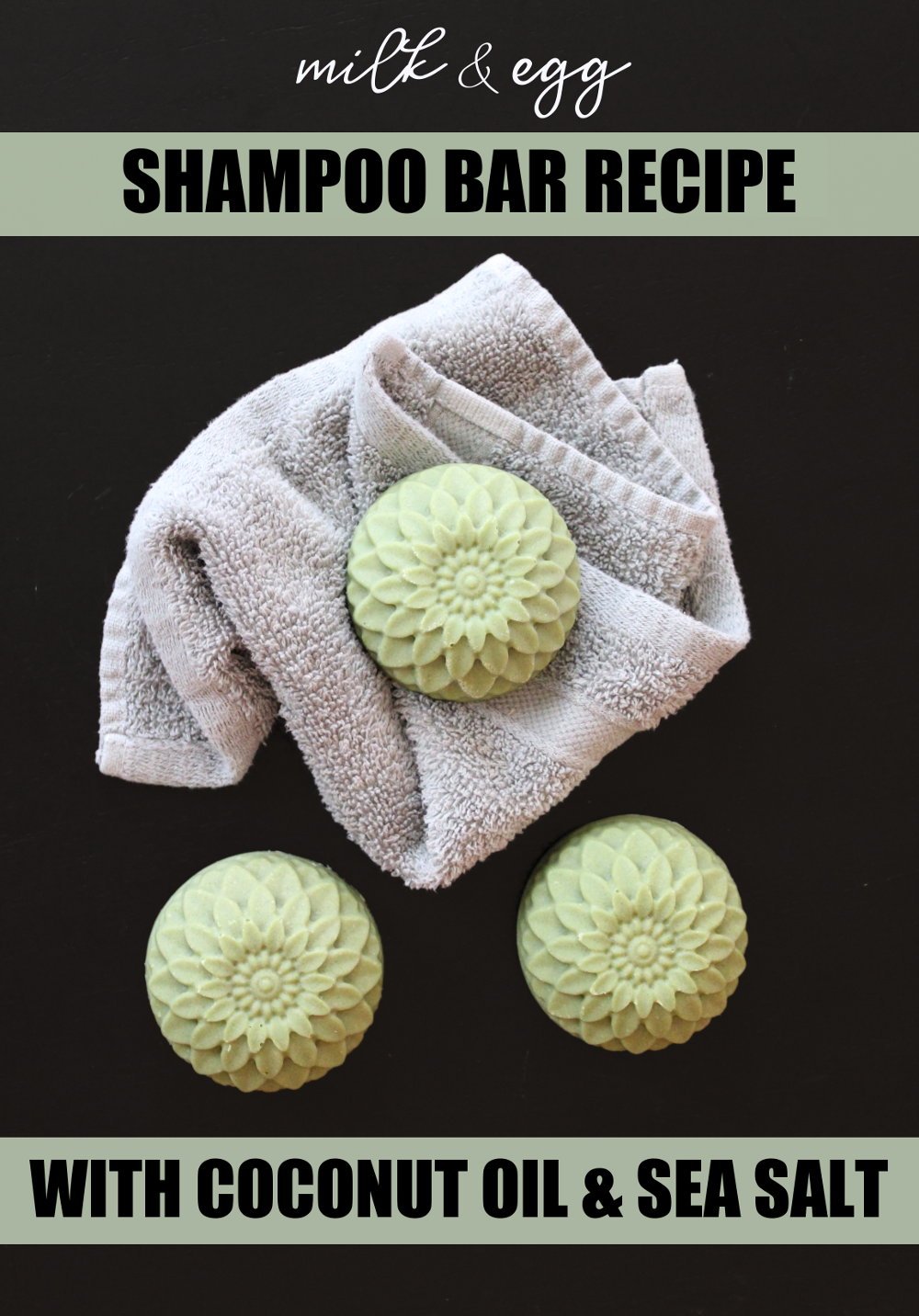
Solid Shampoo Bar Recipe with Sea Salt, Milk & Egg for Shiny Hair
Free of sulfates and surfactants, this sea salt infused solid shampoo bar recipe is made with simple ingredients for a healthy, natural hair care solution. Made with a whole egg or egg yolks in conjunction with sea salt and milk, this cold process soap recipe creates a natural product that’s perfect for shiny hair.

Sea Salt Shampoo Bars
I first discovered and used a salt shampoo from Etsy many many years back. While that particular shop is no longer in business, I always loved the extra volume and texture it gave my hair. Having fine, typically limp hair, the salt brought out my hair’s natural waves that I’d forgotten I have, and made it more lush, thick and luxurious.
I recently rediscovered salt shampoo with Pacifica’s Salty Waves hair care line. This in turn inspired me to create my own milk and egg sea salt shampoo bar infused with ginger and sea kelp.
Solid Shampoo Benefits
Formulated using coconut oil for strong, shiny hair, this natural solid shampoo bar recipe also contains milk and egg to moisturize and condition hair. In addition I also added ginger essential oil and sea kelp for their hair care benefits.
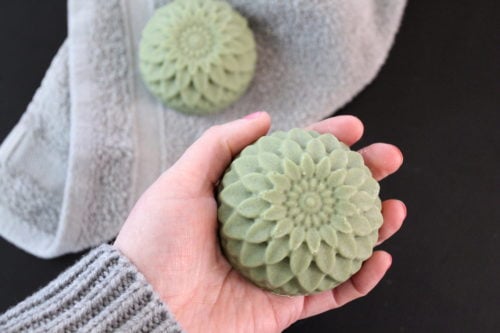
Sea kelp, which is a natural source of iodine, treats dandruff while also strengthening and nourishing both your hair and scalp. Like sea kelp, ginger essential oil also treats dandruff. Additionally, ginger essential oil can boost hair growth and diminish hair loss. It also makes hair soft and shiny. (Not to mention it smells AMAZING!)
Not only will your hair love the combination of ingredients found in my natural sea salt shampoo bar recipe, but you’ll also love how long it lasts! Just one bar should last about the same amount of time as two to three bottles of a similar shampoo in liquid form.
My sea salt shampoo bar recipe contains 75% sea salt and 30% superfat. While salt bars typically make incredibly hard bars of soap, I reduced the water to 30% of the oil in this recipe to compensate for the addition of the egg. You can use either one whole egg for my salt shampoo bar or two egg yolks as desired. (You can learn more about the benefits of egg soap here.)
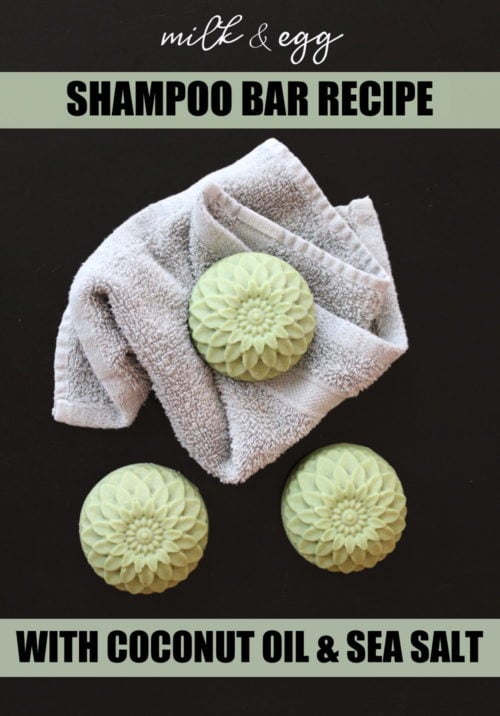
Solid Sea Salt Shampoo Bar Recipe
Get shiny hair with this eco-friendly solid shampoo bar! Natural ingredients nourish your hair for a beautiful, glossy finish. Ditch the single-use plastic bottles and switch to a sustainable solution for your hair care routine today!
Shampoo Bar Ingredients:
As this recipe is meant to be as natural as possible, there are no sulfates — just simple, natural ingredients. If desired, the mica used for a colorant may be omitted. These are the ingredients you’ll need to make this eco-friendly hair care solution:
- 14 oz. coconut oil: Coconut oil is used as the only base oil (or fat) in this cold process soap recipe for its cleansing properties. To avoid an overly cleansing shampoo bar, the superfat has been increased above normal guidelines to lend it conditioning properties and prevent vital oils from being completely stripped from hair.
- 4.2 fl. oz. half and half: Half and half is a mix of milk and cream. While milk is a suitable alternative to half and hair, the extra fats in half and half will give this hair care product additional properties that help condition hair naturally.
- 1.8 oz. sodium hydroxide/lye: In order to make soap, you must use a fat and an alkali. When these ingredients are combined, they go through a chemical process called saponification that transforms the into soap. Lye is used as an alkali to make soap.
- 10.5 oz. fine sea salt: Like regular salt soap bars used to cleanse skin, the sea salt in this shampoo recipe helps to leave hair shiny. The final product won’t turn out the same if this ingredient is omitted. Additionally, it also helps to create a very hard bar of soap due to its inherent properties. Just take care you are using regular sea salt and NOT Dead Sea salt as Dead Sea salt will make your soap “weep” moisture.
- One whole egg (or two egg yolks): Egg yolk has long been used to condition hair and is a common ingredient found in DIY hair masks. Eggs, like milk, act as a fat in soap making with egg yolks giving the final hair care product a rich, creamy and luxurious lather. Further, eggs are packed with proteins and vitamins that can nourish your hair, strengthen the hair follicles and add shine. They also have natural cleansing properties that help to get rid of dirt and oil from the scalp, reducing the amount of buildup.
- 1 Tablespoon kelp powder: Sea kelp is a great source of nourishment for hair health! It is rich in minerals, vitamins, and amino acids, which help to provide deep hydration and nourishment to the scalp and hair follicles. Sea kelp also helps to stimulate hair growth, reduce hair loss, and prevent split ends. Additionally, it helps to protect the hair from environmental damage and keep it looking shiny and healthy.
- .5 oz. fresh ginger essential oil: Ginger essential oil is often included in shampoos because it has many hair-nourishing benefits. It helps to nourish the scalp and hair follicles, promoting healthy hair growth and encouraging strong, glossy hair. It also has antiseptic and antifungal properties which can help to reduce scalp disease and inflammation. Additionally, ginger essential oil can help to reduce dandruff and other scalp conditions.
- 1 teaspoon alpine green mica (optional): If you’d like to color your solid shampoo bars, a quick and easy way is to use mica powder or another soap colorant. This ingredient is optional and may be omitted. Or you can try a natural colorant such a French green clay.
How to Make Solid Shampoo with Sea Salt
My solid shampoo bar recipe with sea salt yields six soap bars weighing about 5 oz. each. I used this silicone chrysanthemum mold to create my soap recipe to shampoo and cleanse hair.
Here is how to make a solid shampoo bar with sea salt:
1. Begin by measuring out the half and half in fluid ounces. Place the half and half in your freezer until it is slushy with a thin layer of ice on top. In the meantime, remove the egg (or eggs) from the refrigerator and bring to room temperature.
TIP: While you are waiting, collect all of the other ingredients and equipment you’ll need for making my sea salt shampoo bar recipe. This includes proper eye protection, long sleeved clothing and gloves, which you should wear whenever working with lye.
TIP: You should also double check any containers you are using to be sure they are heat safe. None of your containers or your utensils used for soap making should be aluminum. Stick to stainless steel, Type 5 polypropylene plastic and tempered glass to avoid a potential disaster.
TIP: If you’ve never made homemade soap before, I recommend reviewing my tutorial on how to make soap from scratch before getting started. This will help you gain a better understanding of the process as well as help you determine if my milk & egg sea salt shampoo bar recipe is the best recipe to start with.
Once your egg or egg yolks reach room temperature and your half and half is icy cold, you are ready to proceed to the next step.
2. Using a digital scale weigh out the coconut oil into a heat safe container. Then, depending on the container used, either heat the coconut oil until melted at reduced power in the microwave, in a double boiler or over medium-low heat on the stovetop. Once melted, remove the coconut oil from heat, then set aside to cool.

3. In a separate container, weigh out the lye called for in the recipe. Pour the lye into the half and half and then stir until all the lye has dissolved. Set aside.
4. In the interim, measure out the kelp powder and mica (for color if desired) and weigh out the ginger essential oil and sea salt.
5. Once your coconut oil has cooled to around 90°F, remove about a cup of the oil from the container. Add the egg (to temper it so you don’t end up with scrambled eggs) and whisk until combined.
8. Now slowly pour the half and half and lye mixture into the main container of melted coconut oil. Mix briefly using an immersion blender, then add the remaining coconut oil and egg called for in my solid shampoo bar recipe.
9. Mix again using the immersion blender until combined, then add the salt, kelp powder, essential oil and mica. Continue mixing until you reach trace, then pour evenly into each of your mold’s six cavities.
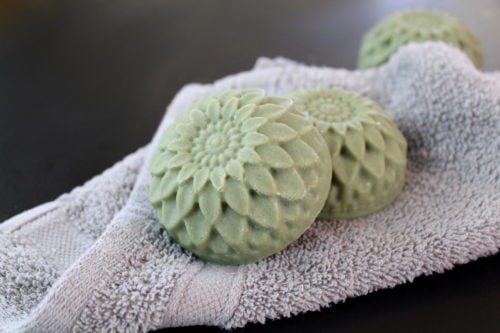
10. Lightly cover the mold with parchment paper or foodservice film and set aside overnight. You can unmold your solid sea salt shampoo bars the next day.
11. All that’s left now is to allow your shampoo bars to cure for four to six weeks prior to use. Once cured, simply massage your shampoo bar onto your wet hair and scalp as desired. Then rinse out and follow with an apple cider vinegar rinse or my homemade scalp tonic recipe.
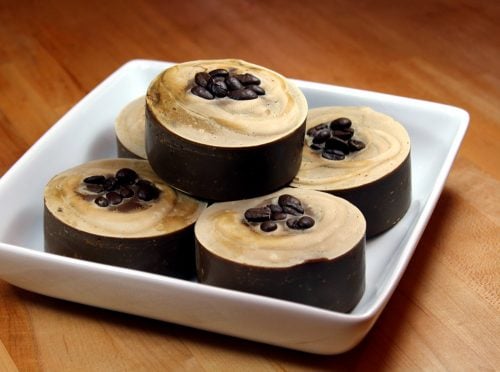
Natural Soap Bar Recipes
If you like my recipe for making a solid shampoo bar with sea salt, then you may also enjoy some of my other homemade soap recipes.
- Cold Process Egg Soap Recipe
- Coffee, Cocoa & Egg Soap Recipe (Pictured above.)
- Lavender Bergamot Salt Bar Recipe
- Basic Bastille Soap Recipe with Essential Oils
- Homemade Yogurt Soap Recipe for Skin Health
- Natural Black Clay & Sea Salt Soap Recipe
- Pink Salt & Sal Butter Soap Recipe
- Cold Process Macadamia Nut Salt Bar Recipe
- Ginger & Lime Shampoo Bar Recipe with Silk
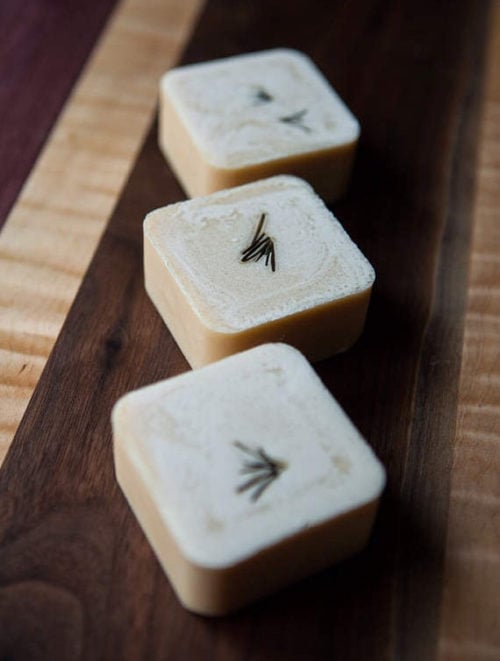
Where to Buy Solid Shampoo Bars
If you’re not quite ready to make my DIY solid shampoo bar with egg and sea salt, but still want to experiment with salt shampoo, here are some of my favorite handmade salty shampoos from Etsy artisans.
- Rosemary Honey & Beer Shampoo Bar with Coconut Oil via Chloe Mason Soap Company (Pictured above.)
- Tea Tree & Mint Sea Salt Shampoo with Moroccan Argan Oil via Sincerity Bath & Body
- Don’t Be Salty Sea Salt Shampoo via Bath Therapy Goods
- Himalayan Pink Salt Shampoo Bar via Chloe Mason Soap Company
- Salt Mine Whip Shampoo via Belle & Blaire Handmade Bath and Body
- Green Tea & Sea Salt Shampoo Bar via Friendly Body Product
To be informed of future soapmaking recipes and projects, be sure to follow Soap Deli News across all of your favorite social media platforms! You can find me on Pinterest, Facebook, Twitter, and Instagram as well as subscribe to Soap Deli News via email for future updates, DIY projects and recipes.
Also, don’t forget. If you make homemade soaps or bath & body products I’d love to see them! Simply add the hashtag #soapdelishowoff to your instagram posts!


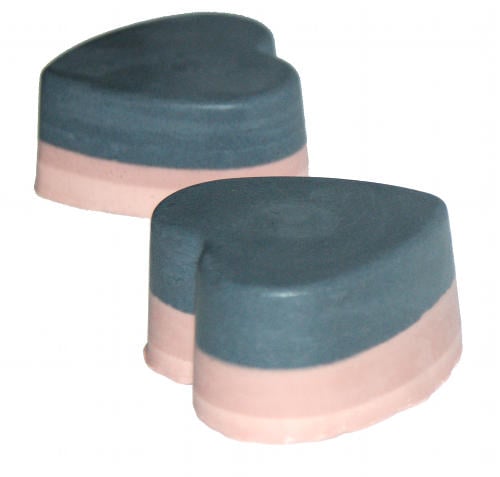

20 Comments
Emma
March 28, 2018 at 7:16 am
Hi!
I just found your shampoo bar receipe and would love to try it!
I was wondering, do you think instead of half and half, goat milk would work?
Thanks!
Rebecca D. Dillon
March 28, 2018 at 8:28 am
Of course. I simply used half and half for the extra fat content and because I always have it on hand.
Margo
April 3, 2018 at 11:24 pm
I would love to give this recipe a try. I have tried making cold processed shampoo bars and have not had one not make my hair feel greasy. Could you tell me what percentage your super fat was used? Thank you for sharing.
Margo
April 3, 2018 at 11:27 pm
Oh I went and read your post again and saw what your super fat was in the recipe.
Rebecca D. Dillon
April 4, 2018 at 7:42 am
It can be easy to miss sometimes. Let me know what you think after you make it and give it a try!
Sally
April 5, 2018 at 8:11 pm
I have made two goes of the salt shampoo, one with plain sea salt on with the pink sea salt. I can hardly wait to try them. Today I made the coffee, cocoa and egg soap. I have never worked with eggs or milk as far as using it with the lye frozen. I have really liked your recipes all this time. I can’t believe how long I have been making soap.
I made the hair tonic to try, will use that tonight. I only use homemade soap shampoos on my hair.
Thanks for the ideas and I am hoping to try some more recipes with that apple fiber stuff, sent for that yesterday.
Rebecca D. Dillon
April 6, 2018 at 11:24 am
I’m so glad you like the recipes! I have so much fun exploring new soap recipes too!
Susan
May 17, 2018 at 11:31 pm
I feel really dumb asking this question, but what ingredient is “half and half” for this recipe?
Rebecca D. Dillon
May 18, 2018 at 11:35 am
It’s half milk and half cream. The stuff you put in coffee.
Christina
May 24, 2018 at 4:23 am
Why do you freeze the half and half and then mix it with the lye?
Rebecca D. Dillon
May 24, 2018 at 9:17 am
It keeps it from scorching and slows down the saponification process until you can get the lye/milk mixture mixed with the oil. The lye reacts to the milk fats the same as it does with your soapmaking oils so you’ll see it start to saponify quickly if its not been chilled.
Eman
July 5, 2018 at 4:41 am
Hey! I love the recipe and would like to try it ..but wasn’t wondering what is the “half and half”?
Rebecca D. Dillon
July 5, 2018 at 11:17 am
Half and half is half cream and half milk. It’s what is commonly put in coffee.
Elea
July 8, 2018 at 9:53 am
Hi ! I was wondering if you could use this shampoo as a soap too, I like multi task things :3
Rebecca D. Dillon
July 9, 2018 at 8:54 am
Absolutely!
Christine
July 28, 2018 at 5:35 pm
I am so interested in your recipe! Is the superfat so high because of the salt? I don’t want to have greasy hair… Other shampoo bar recipes only have up to about 12% from what I am seeing so far, but they don’t include salt. And is that percentage partly because of only using coconut oil? Most recipes have other oils as well like the usual olive, almond castor oil, etc.
Rebecca D. Dillon
July 28, 2018 at 6:04 pm
The superfat is high for two reasons. One, so you still get good lather due to the salt which diminishes lather. And two, coconut oil is super cleansing when used in soap, which can strip skin and hair. So the superfat is also to balance the soap bar back out so it’s not overly cleansing and therefore drying. Your hair definitely won’t be greasy! Instead it will be clean and shiny!
Murielle
August 15, 2018 at 1:36 pm
Many thanks for this receipe I’ll try soon.
I wondered about half and half too (I’m french) but someone asked !
I’m looking (desesperately) for a DIY spray or foamer to get hight volume . I collect ideas .
J
September 22, 2018 at 5:58 pm
Do you have an Etsy page where you sell your soaps too? Thanks for the recipes !
Rebecca D. Dillon
September 22, 2018 at 6:23 pm
Sorry, I don’t sell any of the things I make.
Comments are closed.